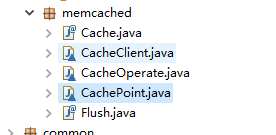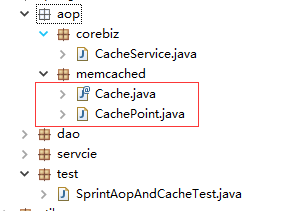spring-aop + memcached 的简单实现
一般情况下,java程序取一条数据是直接从数据库中去取,当数据库达到一定的连接数时,就会处于排队等待状态,某些在一定时间内不会发生变化的数据,完全没必要每次都从数据库中去取,使用spring-aop + memcached 技术,取数据时,先从缓存中去取,缓存中如果存在,直接返回结果,无需访问数据库;如果缓存中不存在,再访问数据库,并把这条数据保存到缓存中,当程序下次再访问时,就可以取到缓存中的值了。这样不但可以大大减少访问数据库的次数(减轻数据的负担),而且可以提高程序的运行效率,因为memecached 是采用key - value 方法存取数据的。但是缓存如果使用不当,不但容易造成数据混乱,而且容易导致意想不到的bug。当然除了使用spring-aop 实现缓存技术之外,也可以使用aspectj 实现。
使用memcached时特别需要注意的是:
1.当某条数据发生变化时,一定要更新cache中的这条记录;
2.设置key时一定要唯一,一般是通过prefix + uuid 保证唯一,prefix一般使用数据库的表名;
3.合理设置缓存的时间,即有效期。
下面来介绍一下spring-aop + memcached 技术的简单实现:
1.定义注解类 @Cache
@Target(ElementType.METHOD)
@Retention(RetentionPolicy.RUNTIME)
public @interface Cache { /**
* key的前缀
* @return
*/
String prefix(); /**
* 指定哪个参数值做Key,与cacheKey两者选一,如果都有输入,默认使用indexKey
* @return
*/
int indexKey() default 0;
/**
* 缓存有效期 1000*60*60*2=2小时,下面代码暂时没有实现此功能
* @return
*/
long expiration() default 1000 * 60 * 60 * 2;
}
2.定义切入点类 CachePoint,这个类一定要与上面的注解类在同一包目录下
@Component
@Aspect
public class CachePoint { @Autowired
private CacheService cacheService; /**
* @Pointcut("@annotation(Cache)") 表示定义切入点所有带有@Cache注解的方法
*/
@Pointcut("@annotation(Cache)")
public void queryCache(){
System.out.println("此输出将不会执行...");
} @Around("queryCache()")
public Object getByCache(ProceedingJoinPoint pjp) throws Throwable {
// 1.查询缓存的值
Object obj = cacheService.getKey("test_1000123456");
// 2.如果缓存中不存在,则查询mysql数据库
if (null==obj) {
obj = pjp.proceed();
// 3.将obj的值写入缓存
cacheService.setKey("test_1000123456", obj);
}
return obj;
} }
3.编写memcached 的业务类
@Component("cacheService")
public class CacheService {
/**
* 读取缓存的方法
* @param key
* @return
*/
public Object getKey(String key) {
System.out.println("query from memcached");
return null;
}
/**
* 写入缓存的方法
* @param key
* @param obj
*/
public void setKey(String key, Object obj) {
}
/**
* 删除缓存的方法
* @param key
*/
public void delete(String key) {
}
}
4.Dao 的实现层添加注解
@Component("testDao")
public class TestDaoImpl implements TestDao {
/**
* 此处将使用 prefix + indexKey 作为缓存的key,即 test_ + uuid
*/
@Cache(indexKey=1, prefix="test_")
@Override
public String query(String uuid) {
System.out.println("query from mysql");
return "caoxiaobo";
}
}
配置文件spring-aop.xml:
<?xml version="1.0" encoding="UTF-8"?>
<beans xmlns="http://www.springframework.org/schema/beans"
xmlns:aop="http://www.springframework.org/schema/aop"
xmlns:xsi="http://www.w3.org/2001/XMLSchema-instance" xmlns:p="http://www.springframework.org/schema/p"
xmlns:context="http://www.springframework.org/schema/context"
xmlns:mvc="http://www.springframework.org/schema/mvc"
xsi:schemaLocation="http://www.springframework.org/schema/beans
http://www.springframework.org/schema/beans/spring-beans-3.1.xsd
http://www.springframework.org/schema/aop
http://www.springframework.org/schema/aop/spring-aop-4.3.xsd
http://www.springframework.org/schema/context
http://www.springframework.org/schema/context/spring-context-3.1.xsd
http://www.springframework.org/schema/mvc
http://www.springframework.org/schema/mvc/spring-mvc-4.0.xsd">
<!-- 自动扫描 -->
<context:component-scan base-package="com.spring.*" />
<!-- 开启注入注解扫描 -->
<context:annotation-config/>
<aop:aspectj-autoproxy/>
</beans>
测试:
@RunWith(SpringJUnit4ClassRunner.class)
@ContextConfiguration(locations = { "classpath:spring-aop.xml" })
public class SprintAopAndCacheTest { @Autowired
TestService testService; @Test
public void test() {
String name = testService.query("1000123456");
System.out.println(name);
}
}
在执行测试代码的时候,除了第一次执行会输出 “query from mysql” 之外,后面都不会执行这条输出语句。
上述代码仅仅只是一个很简单的spring-aop的示例,下面继续修改CachePoint类,来实现 spring-aop + memcached

@Component("cachePoint")
@Aspect
class CachePoint {
/**
* @Pointcut("@annotation(Cache)") 表示定义切入点所有带有@Cache注解的方法
*/
@Pointcut("@annotation(com.rose.aop.memcached.Cache)")
public void cachePointcut(){
System.out.println("此输出将不会执行...");
}
@Around(value="cachePointcut()")
public Object cacheAround(ProceedingJoinPoint pjp) {
return invoke(pjp);
}
/**
* 1.查询
* 2.
* 3.
* 4.删除
* 5.删除并返回
* @return
* @throws Throwable
*/
private Object invoke (ProceedingJoinPoint pjp) {
Object object = null;
Cache cache = this.getCache(pjp);
int operation = cache.operation();
switch (operation) {
case 1:
object = query(pjp, cache);
break;
// 待实现
case 2:
break;
// 待实现
case 3:
break;
case 4:
delete1(pjp, cache);
break;
case 5:
object = delete(pjp, cache);
break;
default:
break;
}
return object;
}
/**
* 通过反射获取cache的对象,包含很多参数
* @param pjp
* Object[] getArgs:返回目标方法的参数
* Signature getSignature:返回目标方法的签名
* Object getTarget:返回被织入增强处理的目标对象
* Object getThis:返回AOP框架为目标对象生成的代理对象
* @return
*/
private Cache getCache(ProceedingJoinPoint pjp) {
Cache cache = null;
try {
Signature signature = pjp.getSignature();
Class<?> clazz = Class.forName(pjp.getTarget().getClass().getName());
Class<?>[] paramTypes = ((MethodSignature) pjp.getSignature()).getMethod().getParameterTypes();
Method method = clazz.getMethod(signature.getName(), paramTypes);
Annotation annotation = method.getAnnotation(Cache.class);
cache = (Cache) annotation;
} catch (ClassNotFoundException e) {
// TODO Auto-generated catch block
e.printStackTrace();
} catch (NoSuchMethodException e) {
// TODO Auto-generated catch block
e.printStackTrace();
} catch (SecurityException e) {
// TODO Auto-generated catch block
e.printStackTrace();
}
return cache;
}
private Object query(ProceedingJoinPoint pjp, Cache cache) {
// 方法传入的参数
Object[] objs = pjp.getArgs();
int indexKey = cache.indexKey();
String prefix = cache.prefix();
String key = prefix + objs[indexKey-1];
System.out.println("key : " + key);
// 1.查询缓存的值
Object obj = CacheOperate.getKey(key);
// 2.如果缓存中不存在,则查询mysql数据库
if (null==obj) {
try {
obj = pjp.proceed();
// 3.将obj的值写入缓存
CacheOperate.setKey(key, obj);
} catch (Throwable e) {
// TODO Auto-generated catch block
e.printStackTrace();
}
}
return obj;
}
private Object delete(ProceedingJoinPoint pjp, Cache cache) {
System.out.println("删除缓存操作");
Object[] objs = pjp.getArgs();
int indexKey = cache.indexKey();
String prefix = cache.prefix();
String key = prefix + objs[indexKey-1];
CacheOperate.delete(key);
try {
return pjp.proceed();
} catch (Throwable e) {
// TODO Auto-generated catch block
e.printStackTrace();
}
return null;
}
private void delete1(ProceedingJoinPoint pjp, Cache cache) {
delete(pjp, cache);
}
}
class CacheOperate {
private static CacheClient cacheClient = CacheClient.getInstance();
/**
* 读取缓存的方法
* @param key
* @return
*/
public static Object getKey(String key) {
System.out.println("查询缓存");
return cacheClient.get(key);
}
/**
* 写入缓存的方法
* @param key
* @param obj
*/
public static void setKey(String key, Object value) {
cacheClient.set(key, value);
}
/**
* 删除缓存的方法
* @param key
*/
public static void delete(String key) {
cacheClient.delete(key);
}
}
memcached的连接及初始化 及增、删、改、查
class CacheClient {
private CacheClient() {}
private static CacheClient cacheClient = null;
private static MemCachedClient client = new MemCachedClient();
// 服务器列表和其权重
private static String[] servers = { "127.0.0.1:11211" };
/**
* 项目启动时(类加载的过程中)连接及初始化
*/
static {
// 获取soket 连接池的实例对象
SockIOPool pool = SockIOPool.getInstance();
// 设置服务器信息
pool.setServers(servers);
pool.setFailover(true);
//设置初始连接数、最小和最大连接数以及最大处理时间
pool.setInitConn(10);
pool.setMinConn(5);
pool.setMaxConn(250);
// 设置主线程的睡眠时间
pool.setMaintSleep(30);
// 设置TCP的参数和连接超时
pool.setNagle(false);
pool.setSocketTO(3000);
pool.setAliveCheck(true);
// 初始化连接池
pool.initialize();
}
public static CacheClient getInstance() {
if (null==cacheClient) {
cacheClient = new CacheClient();
}
return cacheClient;
}
public Object get(String key) {
return client.get(key);
}
public boolean set(String key, Object value) {
return client.set(key, value);
}
public boolean set(String key, Object value, int expiry) {
Calendar nowTime = Calendar.getInstance();
nowTime.add(Calendar.SECOND, expiry);
return client.set(key, value, nowTime.getTime());
}
public boolean add(String key, Object value) {
return client.add(key, value);
}
public boolean add(String key, Object value, int expiry) {
Calendar nowTime = Calendar.getInstance();
nowTime.add(Calendar.SECOND, expiry);
return client.add(key, value, expiry);
}
public boolean replace(String key, Object value) {
return client.replace(key, value);
}
public boolean replace(String key, Object value, int expiry) {
Calendar nowTime = Calendar.getInstance();
nowTime.add(Calendar.SECOND, expiry);
return client.replace(key, value, expiry);
}
public boolean delete(String key) {
return client.delete(key);
}
public boolean flushAll() {
return client.flushAll();
}
}
spring-aop + memcached 的简单实现的更多相关文章
- Spring AOP就是这么简单啦
前言 只有光头才能变强 上一篇已经讲解了Spring IOC知识点一网打尽!,这篇主要是讲解Spring的AOP模块~ 之前我已经写过一篇关于AOP的文章了,那篇把比较重要的知识点都讲解过了一篇啦:S ...
- Spring AOP注解形式简单实现
实现步骤: 1:导入类扫描的注解解析器 命名空间:xmlns:context="http://www.springframework.org/schema/context" xsi ...
- Spring Boot -- Spring AOP原理及简单实现
一.AOP基本概念 什么是AOP,AOP英语全名就是Aspect oriented programming,字面意思就是面向切面编程.面向切面的编程是对面向对象编程的补充,面向对象的编程核心模块是类, ...
- Spring AOP的一个简单实现
针对学习笔记(六)中的购买以及退货代码,我们加入AOP框架,实现同样一个功能. 首先配置XML:service采用和之前一样的代码,只是没有通过实现接口来实现,而是直接一个实现类.transactio ...
- Spring AOP Aspect的简单实现(基于XML)
第一步:导包 第二步:实现类和切面类 Service("userService")public class IUserviceImpl implements IUserServic ...
- Spring AOP Aspect的简单实现(基于注解)
第1步:声明使用注解 <!-- 配置扫描注解--> 扫描包的位置<context:component-scan base-package="com.zz"/> ...
- 转载:Spring AOP (下)
昨天记录了Spring AOP学习的一部分(http://www.cnblogs.com/yanbincn/archive/2012/08/13/2635413.html),本来是想一口气梳理完的.但 ...
- Spring AOP (下)
4.方式二:schema配置 a.业务类: /** * 业务类 * * @author yanbin * */ public class AspectBusiness { /** * 切入点 */ p ...
- (转)spring aop(下)
昨天记录了Spring AOP学习的一部分(http://www.cnblogs.com/yanbincn/archive/2012/08/13/2635413.html),本来是想一口气梳理完的.但 ...
- Spring AOP中的JDK和CGLib动态代理哪个效率更高?
一.背景 今天有小伙伴面试的时候被问到:Spring AOP中JDK 和 CGLib动态代理哪个效率更高? 二.基本概念 首先,我们知道Spring AOP的底层实现有两种方式:一种是JDK动态代理, ...
随机推荐
- scala mapPartitionsWithIndex函数的使用
var rdd1=sc.makeRDD(Array((1,"A"),(2,"B"),(3,"C"),(4,"D")),2 ...
- jmeter-执行多个sql查询语句
1.添加jdbc connection(注意标红部分) 2.添加jdbc request 3.查看结果树
- 深入Jetty源码之Servlet框架及实现(Servlet、Filter、Registration)
概述 Servlet是Server Applet的缩写,即在服务器端运行的小程序,而Servlet框架则是对HTTP服务器(Servlet Container)和用户小程序中间层的标准化和抽象.这一层 ...
- Pandas分类数据
通常实时的数据包括重复的文本列.例如:性别,国家和代码等特征总是重复的.这些是分类数据的例子. 分类变量只能采用有限的数量,而且通常是固定的数量.除了固定长度,分类数据可能有顺序,但不能执行数字操作. ...
- [ SSH 两种验证方式原理 ]
SSH登录方式主要分为两种: 1. 用户名密码验证方式 说明: (1) 当客户端发起ssh请求,服务器会把自己的公钥发送给用户: (2) 用户会根据服务器发来的公钥对密码进行加密: (3) 加密后的信 ...
- Linux:安装Zookeeper
1.下载 wget http://mirror.bit.edu.cn/apache/zookeeper/zookeeper-3.5.3-beta/zookeeper-3.5.3-beta.tar.gz ...
- 016对象——__set __get get_class_methods get_class_vars
<?php /** */ //http://phpbasic.com/004object/16.php?type=admin /*session_start(); $_SESSION['utyp ...
- C++中const指针用法汇总
这里以int类型为例,进行说明,在C++中const是类型修饰符: int a; 定义一个普通的int类型变量a,可对此变量的值进行修改. const int a = 3;与 int const a ...
- ng $http 和远程服务器通信的一个服务。
$http({url:'',method:''}).success().error() 简洁写法:$http.get()$http.post()... 注意事项:①要求返回的数据格式是json格式②在 ...
- Cisco DHCP 配置要点
实验拓扑图:IOU5/6/7模拟主机 IOU1为DHCP服务器 IOU2为DHCP中继器 IOU3/4为局域网内的交换机 在IOU1中配置DHCP配置 IOU2作为DHCP中继,在E0/0.10和E0 ...

